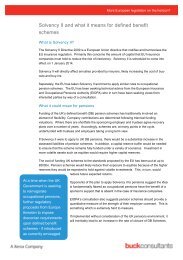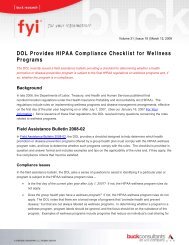Can your long-term incentive plan become more performance based ...
Can your long-term incentive plan become more performance based ...
Can your long-term incentive plan become more performance based ...
Create successful ePaper yourself
Turn your PDF publications into a flip-book with our unique Google optimized e-Paper software.
What is the “appropriate” mix of equity types in an LTIP?<br />
Companies often use a combination of Stock Options,<br />
Restricted Stock, Performance Shares, and multi-year cash<br />
<strong>plan</strong>s, especially in the early years of experimenting with a<br />
new type of <strong>plan</strong>. We suggest limiting the combination to<br />
two types, including Performance Shares. Also,<br />
Compensation Committees sometimes choose to start with<br />
Performance Shares making up less than half of the total<br />
<strong>incentive</strong> opportunity and then increasing that proportion<br />
over time.<br />
As Compensation Committees consider the design issues<br />
surrounding their LTIPs, they must do something of a balancing<br />
act. On the one hand, they must represent the interests of<br />
shareholders, whose natural preference would be for the <strong>more</strong><br />
rigorous and <strong>more</strong> <strong>performance</strong>-<strong>based</strong> behavior that<br />
Performance Shares promote. On the other hand, Compensation<br />
Committee members also know that shareholder interests<br />
include the retention and motivation of senior executives.<br />
These same executives often place a higher value on Restricted<br />
Stock, which has only time-<strong>based</strong> restrictions on receiving the<br />
value. Restricted Stock is often referred to as having “retentive<br />
value” and this can be interpreted to mean that it is better for<br />
or <strong>more</strong> valued by the recipient.<br />
Conclusion<br />
The link between pay and <strong>performance</strong> is paramount in<br />
executive compensation <strong>plan</strong>s. Compensation Committees are<br />
doing a better job of forging this link, as evidenced by the<br />
increasing use of Performance Shares and other <strong>performance</strong><strong>based</strong><br />
LTIPs. Almost all Compensation Committees are at least<br />
discussing these issues. We are still in the early stages of this<br />
movement, but it is happening quickly. As it progresses, it will<br />
be interesting to see how <strong>performance</strong> <strong>plan</strong>s evolve and<br />
whether they grow to be the dominant component of total LTIP<br />
opportunities for top executives.<br />
About the Author:<br />
Larry Schumer, a Boston-<strong>based</strong> principal in Buck’s<br />
Compensation practice, has 15 years of executive compensation<br />
consulting experience. Larry has also served as head of Human<br />
Resources at a technology industry company and a services<br />
industry company, each with <strong>more</strong> than 10,000 employees.<br />
He can be reached at 617.275.8048 or at<br />
larry.schumer@buckconsultants.com.<br />
As Compensation Committees<br />
consider the design issues<br />
surrounding their LTIPs, they must<br />
do something of a balancing act.<br />
© 2008 Buck Consultants, LLC. All rights reserved.<br />
Insight® is a registered trademark and InsightOut tm is a trademark of Buck Consultants, LLC.















